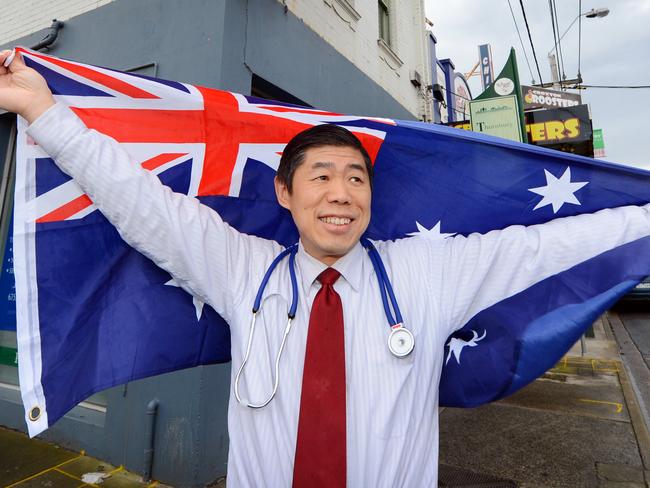How Asian are we really? What Australia’s Census 2016 showed us
ONE of the interesting results in the Census showed a boost in Asian-born residents — but it may not reveal the full picture.
YESTERDAY’S Census results revealed how much Australia is changing with the majority of people born overseas now from Asia, not Europe.
The Australian Bureau of Statistics noted this historic change in its Census 2016 release, which highlights the growing number of Asians living in Australia. However, closer scrutiny of the data gives a fuller picture of what it actually means for Australia.
In coming up with this statistic, the ABS included countries as diverse as India, Pakistan, Georgia, Philippines, China, Maldives, Japan, Nepal, Uzbekistan, Malaysia, Armenia and even Afghanistan in the category of “Asian”.
“Europe” included countries like the UK, France, Italy, Albania and Russia. Residents from these countries dropped from 40.3 per cent of the overseas-born population in 2011, to 33.9 per cent in 2016.
It was the opposite for the Asian population, which grew from 32.9 per cent to 39.7 per cent.
That also leaves about 26 per cent of residents born overseas coming from Africa, Middle East, The Americas, Oceania and Antarctica.
These statistics only relate to the 26 per cent of Australians born overseas, the Census found 67 per cent of residents were born in Australia.
And while the Asian-born population is growing, statistics show England and New Zealand were still the most common countries of birth after Australia.
The next most common countries of birth were China, India and Philippines. These three countries made up 19.5 per cent of those born overseas.
But China and India are now the most common countries of birth for new arrivals and have seen the most growth.
The Chinese now make up 8.3 per cent of those born overseas, up from 6 per cent in 2011. India has also increased from 5.6 per cent to 7.4 per cent.
This growth is less surprising when you consider the number of international students hit a record high last year and the largest numbers came from China and India.
But if you are wondering how many total Australians (or ‘usual residents’ to be exact) were born in China, it’s 2.2 per cent. For India it’s 1.9 per cent. In total, 10.3 per cent of all Australians were born in a country classified as “Asian” by the ABS.
This compares to England on 3.9 per cent and New Zealand on 2.2 per cent.
In other words, there are as many Chinese as there are New Zealand-born residents in Australia.
But this proportion has grown since 2011, whereas those born in England or Australia has declined as a percentage of the population.
IT DEPENDS ON WHERE YOU LIVE
Of course, some places are more diverse than others. In Sydney, which has the largest overseas-born population in Australia, China has overtaken England and New Zealand as the most popular country of birth.
4.7 per cent of the Greater Sydney population comes from a Chinese background, compared to 3.1 per cent from England.
This is a much higher percentage of Chinese than in NSW generally or in Australia.
But China doesn’t even rate a mention in states like the Northern Territory, which has the lowest percentage of people born overseas. The NT’s most common countries of birth are Australia, followed by Philippines (2.6 per cent) and England (2.4 per cent), then New Zealand, India and Greece.
In 2016, 83 per cent of the overseas-born population lived in a capital city compared with 61 per cent of people born in Australia.
MORE OF US BORN OVERSEAS
There has been a small increase in the percentage of Australia’s population who say they were born overseas, from 25 per cent in 2011 to 26 per cent.
Fifty years ago, in 1966, Australia’s overseas-born population was only 18 per cent of the total Australian population.
At that time 32 per cent of this population was born in England, and only 1.6 per cent came from India and China combined.
If you look at ancestry, 36 per cent said they had some English blood and 34 per cent identified as Australian.
But there were 300 ancestries identified in the 2016 Census.
The next most common were those who had a little bit of Irish in them (11 per cent) or Scottish (9.3 per cent).
Chinese was the fifth most common response, with 5.6 per cent of the Australian population saying they had some Chinese background.
Those who had an Indian background made up 4.6 per cent and four other European countries rounded out the top 10.
LANGUAGES
Overall there more than 300 languages spoken in Australian homes (including Auslan – Australian Sign Language).
About 72 per cent of the population speak only English and 21 per cent spoke a language other than English at home.
Of these, Mandarin made up 2.5 per cent and Cantonese was 1.2 per cent.
Those speaking Arabic made up 1.4 per cent, while Vietnamese speakers were 1.2 per cent.
WE’RE A DIVERSE NATION
Australians were born in close to 200 different countries and almost half of the population in 2016 had been born overseas or had at least one parent born overseas.
The Census shows that Australia has a higher proportion of overseas-born people (26 per cent) than the United States (14 per cent), Canada (22 per cent), New Zealand (23 per cent) and the United Kingdom (13 per cent).
About 20.9 per cent had one or both parents born overseas and 50.7 per cent of Australians had a grandparent born overseas.
There’s no escaping it — we are a nation of immigrants.




